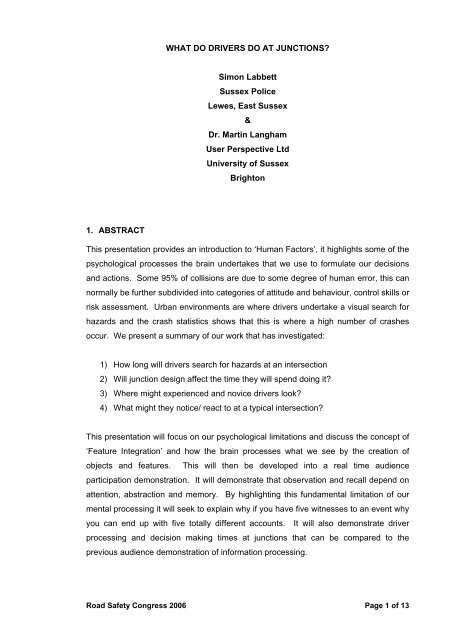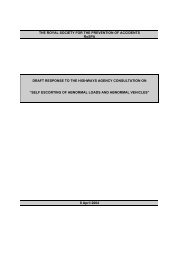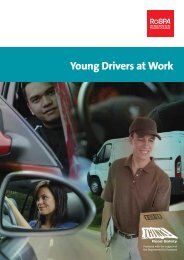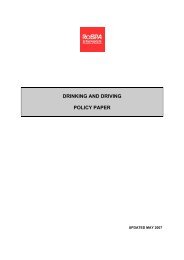Dr. Martin Langham - RoSPA
Dr. Martin Langham - RoSPA
Dr. Martin Langham - RoSPA
You also want an ePaper? Increase the reach of your titles
YUMPU automatically turns print PDFs into web optimized ePapers that Google loves.
WHAT DO DRIVERS DO AT JUNCTIONS?<br />
Simon Labbett<br />
Sussex Police<br />
Lewes, East Sussex<br />
&<br />
<strong>Dr</strong>. <strong>Martin</strong> <strong>Langham</strong><br />
User Perspective Ltd<br />
University of Sussex<br />
Brighton<br />
1. ABSTRACT<br />
This presentation provides an introduction to ‘Human Factors’, it highlights some of the<br />
psychological processes the brain undertakes that we use to formulate our decisions<br />
and actions. Some 95% of collisions are due to some degree of human error, this can<br />
normally be further subdivided into categories of attitude and behaviour, control skills or<br />
risk assessment. Urban environments are where drivers undertake a visual search for<br />
hazards and the crash statistics shows that this is where a high number of crashes<br />
occur. We present a summary of our work that has investigated:<br />
1) How long will drivers search for hazards at an intersection<br />
2) Will junction design affect the time they will spend doing it?<br />
3) Where might experienced and novice drivers look?<br />
4) What might they notice/ react to at a typical intersection?<br />
This presentation will focus on our psychological limitations and discuss the concept of<br />
‘Feature Integration’ and how the brain processes what we see by the creation of<br />
objects and features. This will then be developed into a real time audience<br />
participation demonstration. It will demonstrate that observation and recall depend on<br />
attention, abstraction and memory. By highlighting this fundamental limitation of our<br />
mental processing it will seek to explain why if you have five witnesses to an event why<br />
you can end up with five totally different accounts. It will also demonstrate driver<br />
processing and decision making times at junctions that can be compared to the<br />
previous audience demonstration of information processing.<br />
Road Safety Congress 2006 Page 1 of 13
2. INTRODUCTION<br />
This introductory paper relating to human factors aims to stimulate debate between<br />
collision investigators, highway engineers, safety professionals and psychologists. The<br />
paper presents joint research between an academic organisation and police collision<br />
investigation. The paper provides an insight into the current thinking within the Human<br />
Factors profession regarding one aspect of driver behaviour – visual search at highway<br />
intersections. The topic reported here reflects the most common questions asked by<br />
collision investigators about driver behaviour. That is:-<br />
“What does a normal driver do at a junction – how long should they look before<br />
they see something and why can they “look but not see”?<br />
So this article investigates why a driver may ‘look but fail to see’ another road user<br />
(especially vulnerable users) and reports data that indicates:<br />
• How long do drivers look for?<br />
• Where do they look?<br />
• What might they see?<br />
We have selected only some examples from our work and most is published in<br />
journals, conference proceedings (available form most libraries), or technical reports<br />
available from TRL Ltd.<br />
2.1 The looked but failed to see error<br />
The ‘looked but failed to see’ error or ‘looked but did not see’ (Sabey and Staughton<br />
1975, Staughton and Storie 1977) refers to a set of circumstances where a driver<br />
accounts for an accident in terms of failing to detect another road user in time to avoid<br />
a collision. The explanation of ‘looking and failing to see’ (L.B.F.S) also implies that the<br />
other vehicle was there to be seen by the offending driver. The term ‘L.B.F.S. error’ is<br />
used by Sabey to refer to accidents in which, during the post incident interview, the<br />
driver of the offending vehicle claimed not to have detected the other road user before<br />
the collision occurred. Sabey et al.’s (1975) found that 44% of 2,036 accidents<br />
appeared to have been produced by a perceptual error and in their judgement post<br />
accident interviews revealed that ‘distraction’ and ‘looked but failed to see’ errors were<br />
Road Safety Congress 2006 Page 2 of 13
the most common form of perceptual errors made by drivers. Cairney and Catchpole<br />
(1995) estimate that 69-80% of all intersection accidents are failures by one driver to<br />
‘see’ another until it is too late.<br />
Rumar (1990) describes late detection or L.B.F.S. error as a common problem<br />
accounting for the majority of multi-vehicle accidents throughout Europe. A detection<br />
error is the basic cause, claims Rumar, because without detection no further<br />
processing of information, or decision processes can take place. Rumar identified two<br />
important causes of the late detection error:<br />
• A lapse of cognitive expectation, illustrated by the failure to scan for a particular<br />
class of road user, or a failure to look in the appropriate direction.<br />
• A difficulty with perceptual thresholds, illustrated by the failure to discern the<br />
relevant stimuli in lower levels of ambient illumination or in situations where vehicles<br />
approach in the peripheral visual field.<br />
3. HOW LONG DO THEY LOOK FOR?<br />
It appears a very basic question? How much resource time does a driver allocate to<br />
search for other road users at an intersection and what does this tell us about the claim<br />
that drivers ‘look’ but then fail to ‘see’ an approaching vehicle? Additionally, does the<br />
design of the junction, its visibility properties, and whether the driver is familiar (or not)<br />
with its layout affect the amount of time a driver will spend looking? The question is<br />
important for forensic practitioners who need to inform the court of the typical reaction<br />
times (for a review see Hole and <strong>Langham</strong> 1997) and search times that drivers need<br />
when transiting an intersection.<br />
3.1 Methodology<br />
A hidden video camera was mounted at one of two junctions. The video camera<br />
(Panasonic SVHS) was fitted with a 12x zoom lens. Two junctions 20 metres apart<br />
were selected. They had different visibility properties but a similar background. The<br />
short approach junction (SA) had no view of the main road unless the driver’s vehicle<br />
was on the give-way line. The long approach junction (LA) had an uninterrupted view<br />
of the main road for several hundred metres – see figure 1.<br />
Road Safety Congress 2006 Page 3 of 13
The junctions selected were on the University of Sussex campus. The advantage of<br />
using these junctions was that the university issues parking badges to vehicles that<br />
regularly use the campus. With such labelling (a small badge on the windscreen) a<br />
reasonable assessment could be made between those who regularly use these<br />
junctions and those who do not. The filming was conducted during the Open University<br />
Summer school when students who were unfamiliar with the locations visited the<br />
university in numbers and their vehicles did not display the university parking permit.<br />
Figure 1 Plan view of the two junctions under surveillance<br />
Y<br />
X<br />
Obstruction<br />
Short<br />
Approach<br />
Junction<br />
(SA)<br />
Long<br />
Approach<br />
Junction (LA)<br />
North<br />
Camera Positions<br />
X Long Approach<br />
Y Short Approach<br />
Point at which the<br />
driver is capable of viewing the<br />
intersection<br />
Road Safety Congress 2006 Page 4 of 13
Figure 2 The view from the long approach junction<br />
Figure 3 The restricted view of the short approach junction<br />
3.2 Results and Discussion<br />
The table below indicates that drivers appear to search for a very limited amount of<br />
time at an intersection. Despite the potential risks of an incomplete visual search and a<br />
failure to detect a vehicle at a junction, the drivers observed spent less than 0.5<br />
seconds searching for hazards.<br />
Road Safety Congress 2006 Page 5 of 13
<strong>Dr</strong>ivers tend to search in one direction only. <strong>Dr</strong>ivers’ behaviour is relatively constant<br />
across visibility conditions (i.e. SA and LA) and familiarity with the junction. Mean<br />
search times found imply that drivers may be conducting a rapid search of their<br />
environment and may not be attending to every detail.<br />
The 0.5 second search time may be an indication the drivers use their limited cognitive<br />
resources to search in either limited parts of the road environment or search only for<br />
certain categories of objects for identification. The fact that mean search time was<br />
under 0.5 seconds implies that the driver is only looking in limited parts of the road and<br />
may not be individually assessing each of its constituent parts. During a short search<br />
time how much detail is the driver extracting? Is the driver reviewing every detail of the<br />
scene? Or is the driver looking for a description of what might be a hazard?<br />
Table 1 Mean amount of time in seconds drivers spent looking for hazards at<br />
both junctions<br />
Type of approach<br />
SA<br />
LA<br />
<strong>Dr</strong>iver Mean SD Min Max. Mean SD Min Max.<br />
University 0.4 0.2 * 2 0.39 0.012 0.83 0.778<br />
Visitor 0.44 0.08 0.4 1 5 0.36 0.03 * 6<br />
* indicates when drivers did not look.<br />
4. WHERE DO THEY LOOK?<br />
One alternative explanation for the L.B.F.S. error is to suggest that drivers might be<br />
failing to direct their gaze towards parts of the road environment (e.g. Olson 1989)<br />
where vulnerable road users such as motorcyclists drive.<br />
Rumar (1990) claims that because of driver expectancy, the driver fails to scan or look<br />
in the places where an uncommon vehicle may be present. Summala et al. (1996)<br />
found that a cause of bicycle collisions is that drivers developed a visual search<br />
strategy which ignores visual information about less frequent dangers.<br />
Road Safety Congress 2006 Page 6 of 13
<strong>Dr</strong>ivers may develop through experience a visual scanning pattern that is well suited to<br />
detect commonly-occurring vehicle types (cars, lorries and buses) but inappropriate for<br />
the effective detection of relatively rarely-seen vehicles such as motorcycles.<br />
Despite driver interactions at junctions being a major source of collisions, most drivers<br />
do not however routinely crash at such intersections, suggesting they must be<br />
generally operating quite effectively in terms of extracting relevant information about<br />
the presence or absence of other road users and their speed of approach (Cairney et<br />
al. 1995). Do drivers look in the ‘right’ places to detect motorcycles? If drivers are<br />
using peripheral vision to detect oncoming vehicles, they might be missing<br />
motorcyclists because they are too small to be detected or because peripheral vision is<br />
poor at recognising form (Olson et al. 1979).<br />
What might they see?<br />
We sample from our environment in a series of relatively brief fixations which move<br />
from one point to another via a series of rapid jerks known as saccades. We can look<br />
at whatever we choose. Consequently this control over saccadic movements has been<br />
seen as an overt indicator of hidden cognitive processes (Chekaluk, et al. 1992).<br />
Sequences of fixations are a popular way of emphasising the link between overt<br />
behaviour and higher mental activities namely the presence of a temporal structure for<br />
planned fixation sequences (See Zingale and Kowler, 1987).<br />
We therefore conducted a laboratory investigation examining where drivers look at the<br />
intersection we describe above.<br />
4.1 Methodology<br />
Film recording and editing were performed by a professional film crew. The stimuli<br />
consisted of eight two-second video clips (each lasting for 48 video frames), displayed<br />
onto a white screen 1.1 metres away from the experimental participant. Video clips<br />
were first generation copies. Clips were separated by ten second gaps. Participants (7<br />
novice drivers and 7 experienced drivers) were informed of a clip's onset by a three<br />
second counter (black digits on a white background) similar in nature to a film start<br />
timer code, which appeared in the centre of the screen. The participants then viewed<br />
the eight two-second video clips.<br />
Road Safety Congress 2006 Page 7 of 13
The video clips showed several different types of junctions, including six scenes of a ‘T’<br />
junction and one scene of a roundabout. The eight clips used contained either traffic<br />
coming towards the driver, going away from the driver or contained no moving vehicles.<br />
Video clips were played on a Panasonic SVHS video recorder, and projected onto a<br />
2m x 2m white screen by a Bell and Howell SVHS L.C.D projector. The resultant<br />
image was 31° horizontal and 22° vertical. Participants wore the ‘Sussex Eyemark’<br />
eye-tracking equipment (for a full description see Land 1992). This consists of a headmounted<br />
Panasonic penlight camera which records both the scene in front of the<br />
wearer and an image of the wearer's eye (via a small half-silvered mirror mounted<br />
beneath the eye).<br />
4.2 Results and Discussion<br />
Figure 2 shows a representative search pattern of two different types of driver. One of<br />
the participants is an experienced driver and the other is new to driving. Although the<br />
experimental participants were allowed two seconds to search the image for other road<br />
users very different search patterns were found between novice and experienced<br />
drivers. The experienced drivers tended to fixate on only small areas of the screen<br />
whilst novice drivers tended to search many parts of the scene. The images presented<br />
here are of only two participants but are representative of all those who took part in the<br />
experiment.<br />
Figure 4 Illustrates a typical fixation pattern of a experienced driver (in red) and a<br />
novice driver (in blue)<br />
Road Safety Congress 2006 Page 8 of 13
Figure 5 Illustrates the search pattern and order in which fixations are made<br />
when a vehicle is present. The blue number boxes represent the novice driver<br />
and the red numbered boxes represent the experienced driver. The numbers in<br />
each of the boxes represent the order in which fixations were made.<br />
Figure 3 shows that where drivers look first and the subsequent locations to which they<br />
fixate may be determined by experience. The two experimental participants shown<br />
here are generally representative of their groups. The data may indicate that<br />
experienced driver fixate in areas of the road environment that ‘experience’ has taught<br />
them where hazards can be found. The novice driver here actually detected the<br />
moving motorcyclists more rapidly than did the experienced participant.<br />
5. WHAT MIGHT THEY SEE?<br />
To conclude the presentation we will discuss the concepts of ‘Feature Integration’ and<br />
‘Change Blindness’ and how these concepts may further contribute to some ‘look but<br />
fail to see collisions’. Feature integration seeks to introduce the process of abstraction<br />
of visual information. Change blindness demonstrates and further highlights how little<br />
information we actually abstract from our environment and how a momentary break in<br />
the visual process can lead to significant change in what we see being otherwise<br />
unobserved.<br />
5.1 Feature Integration<br />
When designing an intervention measure to assist in reducing collisions consideration<br />
maybe being given to the placement of signs or a change of layout. It is therefore<br />
useful in this paper to introduce how as humans we process visual information and also<br />
to highlight our limitations.<br />
Road Safety Congress 2006 Page 9 of 13
The human ability to detect apparent motion is strong, perhaps related to the concept<br />
of prey or predator for survival (Ramachandran & Antis 1986). The brain has an<br />
extensive, but not an exhaustive, capacity to process visual images, thus, the brain<br />
must select to perceive, (Treisman and Gelade, 1980). The theory of Featureintegration<br />
proposes that there are features and objects, the background features are<br />
automatically extracted and assembled into objects. Features require little processing,<br />
yet details of objects require to be taken into attention and abstracted. For example,<br />
take a view of a meadow, wherever an observer looks the visual field is full of<br />
background visual information but it lacks specific detail. When the observer studies<br />
the view further an oak tree and a black and white cow maybe identified within the<br />
general meadow setting. The background features (the general meadow view) are<br />
automatically extracted but the brain has not processed any detail. The objects (the<br />
oak tree and the cow) take greater time to process and abstract before being taken into<br />
attention.<br />
What we as individuals attend to at any time is an almost unanswerable question and is<br />
dependent on many factors. It could be the way that an object was moving, its colour,<br />
its size or something that holds an interest. (Loftus 1996). When designing an<br />
intervention scheme consideration must therefore be given to how best assure the<br />
intended information will be abstracted from the background features. Considerations<br />
are likely to focus on the colour, size, shape, movement and the time available for<br />
detection. These factors should not be considered in isolation but in conjunction with<br />
the existing complexity of the background environment in which the intervention is to be<br />
located.<br />
5.2 Change Blindness<br />
Change blindness is a phenomenon in visual perception in which very large changes<br />
occurring in full view in a visual scene go unnoticed. The presentation we show uses a<br />
series of static images of road environment scenes with differences in some of the<br />
images considered safety critical to illustrate this phenomenon. The changes are what<br />
road users might be expected to experience during driving such as different traffic<br />
signal displays, approaching vehicles at an intersection, and changes in road markings.<br />
With large volumes of information to process in our surrounding environment, we must<br />
constantly allocate or devote our attention to selective processes to be able to interpret<br />
the wealth of input available. Should we devote attention to particular elements either<br />
due to expectation (or lack of) and task demand, then we may become effectively blind<br />
to what else is happening in that environment.<br />
Road Safety Congress 2006 Page 10 of 13
For a review of change blindness literature and demonstrations see Professor<br />
Rensinks website -http://www.psych.ubc.ca/~rensink/<br />
Figure 6 illustrates the images are task we set. Conference delegates will see an<br />
image representing a traffic scene. The first image will disappear and after two<br />
seconds and another image will appear. The image will either be the same, or<br />
would have been changed Changes will relate to road safety. Delegates need to<br />
note if the series of six pairs of images we present are the same or contain<br />
changes.<br />
6. CONCLUSIONS AND FUTURE DIRECTION<br />
If casualty reductions are to be sustained then it is fundamental to look beyond the<br />
physical attributes of the collision when designing effective intervention measures.<br />
Such detail is not necessarily contained in national collision records and as a result<br />
incorrect analysis of physical data can lead to inappropriate measures that fail to<br />
address significant underlying causation factors.<br />
Road Safety Congress 2006 Page 11 of 13
Understanding that humans have limited cognitive resources and rely on their<br />
expectations about the road environment should promote safety organisations and<br />
highway engineers to carefully plan their intervention measures and to think about the<br />
design of even a simple junction.<br />
We conclude our presentation with a request that collision investigators, highway<br />
engineers, safety organisations and psychologists should talk more to each other.<br />
Each profession is still fairly insular with few conferences held to bring the professions<br />
together. A notable exception is today. Research by psychologists can have a direct<br />
impact on other professions and can contribute widely to a safer road environment.<br />
Police collision investigators should gain a basic understanding of human factors and<br />
psychology to enable them to step into the shoes of the offending driver and<br />
understand why the incident occurred.<br />
If police collision investigators have the correct frame of reference and knowledge of<br />
why collisions occur we can elevate their role from simple forensic investigation and<br />
reporting to that of collision prevention. Current work with Sussex police has led to<br />
improvements in night time visibility of pedestrians (<strong>Langham</strong> and Moberly, 2003), a<br />
more scientific understanding of increases in motorcycle causality rates (Labbett and<br />
<strong>Langham</strong> 2005) and improved in-vehicle design (Hampton and <strong>Langham</strong>, 2004).<br />
7. REFERENCES<br />
Cairney, P. and Catchpole, J. 1995, Patterns of perceptual failure at intersections of<br />
arterial roads and local streets, in Gale, A. G. (ed.), Vision in Vehicles, VI, (Elsevier<br />
Science, Amersterdam).<br />
Chekaluk, E. and Llewellyn, K. R. 1992, From the preface The Role of eye-movements<br />
in perceptual processes (North Holland, Netherlands).<br />
Sabey, B., Staughton, G. C. 1975, Interacting Roles Of Road Environment, Vehicle<br />
And Road User, in Accidents Paper Presented To The 5th International Conference Of<br />
The International Association For Accident Traffic Medicine, 1975, London, TRRL,<br />
Crowthorne, Berkshire.<br />
Road Safety Congress 2006 Page 12 of 13
Staughton, G. C. and Storie, V. J. 1977, Methodology of an in-depth accident<br />
investigation, Survey Report no 672, TRRL, Crowthorne, Berks.<br />
Hampton, P. and <strong>Langham</strong>, M.P. 2005 A contextual study of police car telematics: the<br />
future of in-car information systems Ergonomics 48 (2) /109 - 118<br />
Hole, G. J. and <strong>Langham</strong>, M.P. 1997 Some Factors Affecting <strong>Dr</strong>ivers' Reaction Times.<br />
Technical report ITAI (www.itai.org/Technical%20Papers.htm)<br />
Labbett, S. and <strong>Langham</strong>, M.P. 2005 Training can make the problem worse Paper<br />
presented at the 70th <strong>RoSPA</strong> congress Brighton Metropole Hotel February 2005<br />
Land, M. F. 1992, Predictable eye-head co-ordination during driving, Nature, 359,<br />
September, 318-320.<br />
<strong>Langham</strong>, M.P. and Moberly, N.J. (2003) Pedestrian conspicuity research: a<br />
review. Ergonomics, 46:4, 345-363.<br />
Loftus, E.F. (1996) Eyewitness testimony, Cambridge, MA: Harvard University Press.<br />
Ramachandran V.S. & Antis, S.M. (1986) The perception of apparent motion. Scientific<br />
American, 254, 80-87<br />
Rumar, K. 1990, The basic driver error: Late detection. Commission of the European<br />
Communities Workshop: Errors in the operation of transport systems (1989,<br />
Cambridge, England), Ergonomics, 33 (10-11), 1281-1290<br />
Summala, H., Pasanen, E., Rasanen, M., Sievanen, J. 1996, Bicycle Accidents and<br />
<strong>Dr</strong>ivers’ Visual search at left and right turns, Accident Analysis and Prevention, 147-<br />
153.<br />
Treisman, A. M. & Gelade, G. (1980) A feature-integration theory of attention. Cognitive<br />
Psychology, 12, 97-136<br />
Zingale, C. M. and Kowler, E. 1987, Planning sequences of saccades, Vision<br />
Research, 27, 1327-1341.<br />
Road Safety Congress 2006 Page 13 of 13

















